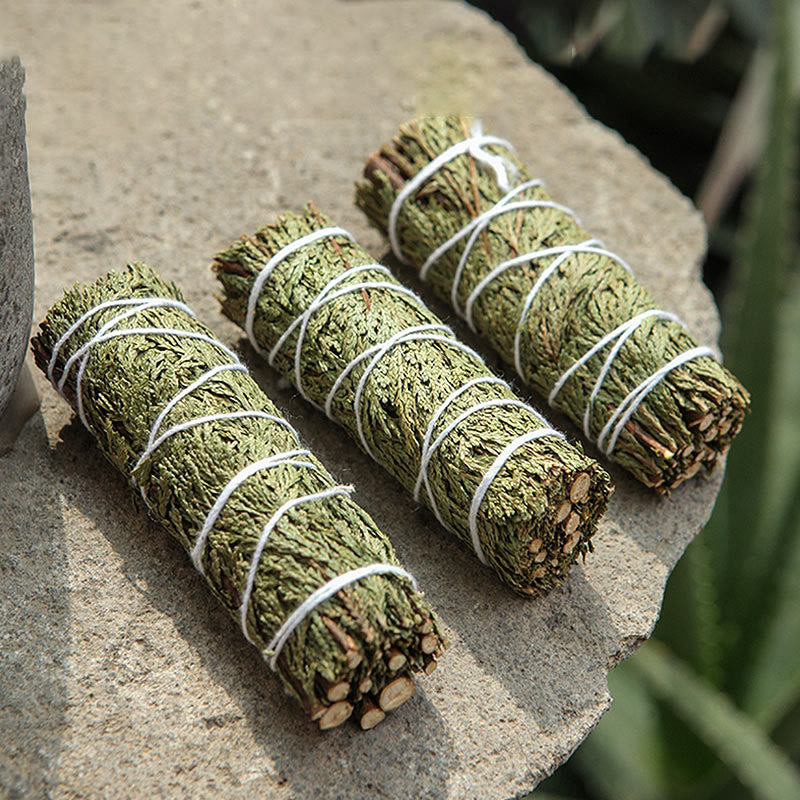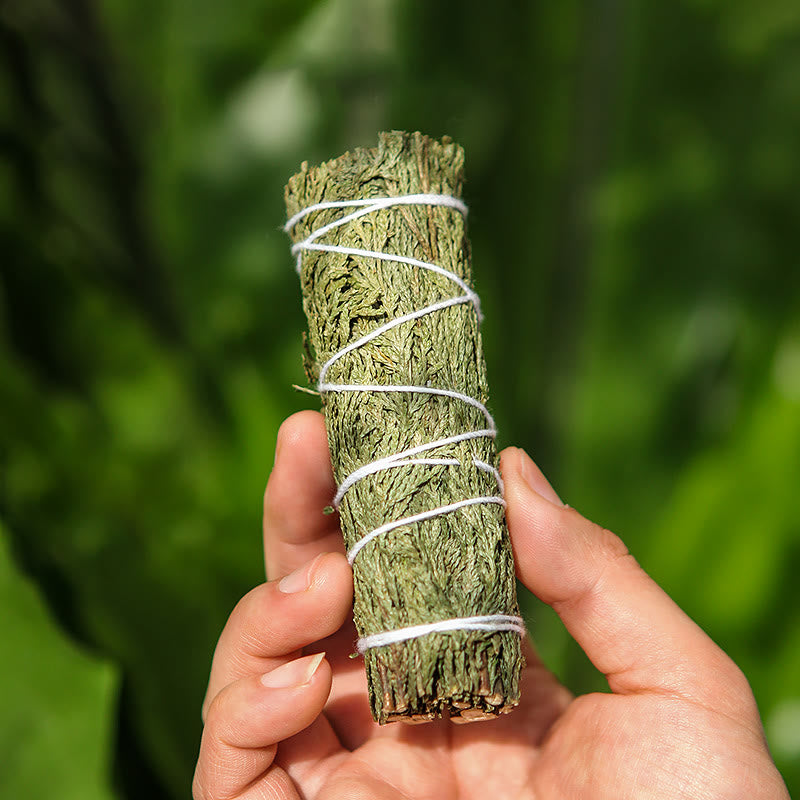La pratique ancestrale de la fumigation, qui consiste à brûler des plantes sacrées pour créer un bain de fumée purifiant, est un rituel précieux dans de nombreuses cultures depuis des siècles. C'est un moyen puissant de purifier un espace, d'évacuer les énergies stagnantes et de formuler de nouvelles intentions. Mais la véritable magie réside dans le choix des plantes pour la fumigation , car chaque plante possède une énergie et une fonction uniques. Que vous soyez novice dans cette pratique ou que vous souhaitiez approfondir votre compréhension, ce guide explorera les plantes de fumigation les plus vénérées pour vous aider à optimiser votre routine de bien-être spirituel.
De la puissante purification de la sauge à l'étreinte protectrice du cèdre, comprendre les propriétés spécifiques de chaque plante vous permet d'adapter vos rituels à vos besoins spécifiques. Nous explorerons les usages et les bienfaits de ces plantes sacrées, vous permettant de créer une atmosphère plus consciente et réfléchie dans votre maison et votre vie.
Qu’est-ce que le maculage et pourquoi utilisons-nous des herbes ?
La fumigation est une pratique cérémonielle qui consiste à brûler des herbes séchées pour créer une fumée sacrée. Cette fumée est ensuite projetée intentionnellement autour d'une personne, d'un objet ou d'un espace afin de le purifier de toute énergie négative ou stagnante. Bien plus qu'un simple assainisseur d'air, c'est un acte purificateur profondément conscient. La croyance fondamentale est que la fumée s'attache aux énergies négatives et, en se dissipant, les emporte.
Les bienfaits de la fumigation aux herbes sont multiples et touchent les domaines spirituel, mental et émotionnel. Cette pratique est souvent utilisée pour :
- Purifiez et nettoyez une nouvelle maison, un bureau ou un espace sacré.
- Éliminez l’énergie négative persistante après une dispute ou une maladie.
- Définissez une intention positive et créez une atmosphère calme pour la méditation ou le yoga.
- Favoriser la pleine conscience et le sentiment de connexion au moment présent.
- Honorez les traditions anciennes et connectez-vous à la sagesse des plantes sacrées.
Chaque herbe apporte une vibration unique au rituel, faisant du choix de la plante un élément essentiel du processus.

Les herbes les plus puissantes pour les rituels de purification
Si la sauge blanche est l'herbe de purification la plus connue, de nombreuses autres plantes offrent de puissants bienfaits énergétiques. Explorer ces alternatives peut enrichir vos cérémonies de purification en y ajoutant une dimension intentionnelle et une efficacité accrues.
Sauge blanche (Salvia apiana) : le purificateur classique
La sauge blanche est sans doute l'herbe la plus célèbre pour la purification. Vénérée dans de nombreuses traditions amérindiennes, elle est reconnue pour ses intenses propriétés purifiantes. Sa fumée puissante et aromatique est réputée pour dissiper les vibrations négatives les plus tenaces, la rendant idéale pour une purification en profondeur. Utilisez la sauge blanche lorsque vous avez besoin de réinitialiser complètement l'énergie d'un espace , par exemple après un emménagement ou une période de bouleversements émotionnels. En raison de son caractère sacré et des problèmes de surexploitation, il est crucial de s'approvisionner de manière durable auprès de fournisseurs réputés.
Cèdre : pour la protection et l'ancrage
Le cèdre est une autre plante sacrée utilisée depuis longtemps dans les rituels de purification et de guérison. Son énergie est profondément protectrice et apaisante. Contrairement à la sauge, qui chasse principalement les énergies négatives, le cèdre est connu pour attirer l'énergie positive et créer un bouclier protecteur autour d'un espace. Son arôme frais et boisé évoque les forêts anciennes et la stabilité. La fumigation au cèdre est idéale pour fortifier l'énergie de votre maison, vous ancrer avant la méditation ou consacrer un nouvel objet sacré. Elle contribue à créer un espace à la fois sûr et sacré.

Bâtonnet de cèdre pour les rituels de purification et de méditation de la maison
$18.90 $27.90
Purifiez votre espace et invitez l'énergie positive avec un bâton de cèdre authentique et issu de sources durables pour les rituels quotidiens.
Explorer le produitRomarin : Pour la clarté et les nouveaux départs
Souvent présent dans les potagers, le romarin est une herbe de purification puissante qui favorise la clarté mentale et apporte une énergie nouvelle. Son parfum vivifiant est reconnu pour améliorer la mémoire et la concentration, ce qui en fait un excellent choix pour purifier votre espace de travail ou avant de vous lancer dans des projets créatifs. Purifier votre espace de travail avec du romarin, c'est comme ouvrir une fenêtre pour laisser entrer une brise fraîche. Il est particulièrement utile pour les rituels axés sur les nouveaux départs , aidant à se libérer des anciens schémas et à saisir de nouvelles opportunités avec un esprit clair et un cœur ouvert.
Sweetgrass : inviter à la positivité et à la douceur
Le foin d'odeur est souvent utilisé après une purification en profondeur à la sauge ou au cèdre. Si la sauge élimine la négativité, le foin d'odeur permet d' inviter une énergie positive et douce pour combler le vide créé. Il ne brûle généralement pas comme les autres herbes ; ses longs brins tressés se consument doucement, libérant un doux parfum vanillé. Dans de nombreuses traditions, il est considéré comme le cheveu sacré de la Terre Mère, et sa fumée est utilisée pour bénir, prier et attirer les esprits bienveillants. Utilisez le foin d'odeur pour apporter calme, paix et positivité à votre espace purifié.
Un guide rapide sur vos herbes de purification
Le choix de la plante idéale dépend entièrement de votre intention. Recherchez-vous une purification profonde, une protection, une clarté mentale ou une énergie positive ? Ce guide rapide vous aidera à choisir la plante idéale pour votre prochain rituel.

[curseur de collection]
Améliorer votre rituel de purification
Au-delà des plantes elles-mêmes, vous pouvez approfondir votre pratique de la purification avec des outils complémentaires qui ancrent votre énergie et élèvent l'atmosphère. Porter des pierres protectrices ou intégrer des sons peut transformer une simple purification en une cérémonie profonde. Pour en savoir plus sur l'histoire et l'importance de ces plantes sacrées, vous pouvez consulter des ressources comme les articles du National Park Service sur les plantes sacrées , qui rendent hommage à leur signification culturelle.
Améliorez votre pratique avec ces outils
$24.90
Ancrez vos intentions et amplifiez la protection spirituelle pendant les pratiques de purification avec ce bracelet d'obsidienne équilibrant l'énergie. En savoir plus ➔
$379.90
$489.90
Amplifiez vos rituels de purification aux herbes avec les sons apaisants d'une flûte de bourdon en cèdre aromatique fabriquée à la main, honorant les traditions anciennes. En savoir plus ➔
Un rituel de purification simple, étape par étape
Prêt à commencer ? Voici un aperçu de base pour une cérémonie de purification. N'oubliez pas : votre intention est primordiale.
- Définissez votre intention : Avant d’allumer vos herbes, prenez un moment pour clarifier ce que vous souhaitez accomplir. Êtes-vous en train de dissiper la négativité, d’inviter la paix ou de bénir votre espace ? Gardez cette intention à l’esprit.
- Allumez les herbes : Tenez votre bâtonnet à 45 degrés et allumez-le avec une allumette ou un briquet. Laissez brûler 30 secondes à une minute, puis soufflez doucement sur la flamme.
- Diffusez la fumée : Les extrémités des feuilles devraient maintenant se consumer lentement, libérant une épaisse fumée. Munissez-vous d'un bol ignifuge, comme une coquille d'ormeau, pour recueillir les braises. À l'aide de votre main ou d'une plume, diffusez délicatement la fumée autour de votre corps, d'une pièce ou d'un objet.
- Couvrir la zone : Parcourez la pièce en insistant sur les coins, les portes et les fenêtres où l'énergie peut stagner. Pour une personne, parcourez délicatement le corps avec la fumée, de la tête aux pieds.
- Éteindre en toute sécurité : Une fois terminé, enfoncez délicatement l'extrémité brûlante du bâtonnet dans un bol ignifuge, du sable ou de la terre jusqu'à ce que la fumée cesse. Assurez-vous qu'il est complètement éteint avant de le laisser sans surveillance.
Conclusion
Intégrer des plantes pour la purification à votre routine bien-être est une belle façon de renouer avec des traditions ancestrales et de prendre soin de soi en pleine conscience. En comprenant les énergies uniques de la sauge, du cèdre, du romarin et du foin d'odeur, vous pouvez choisir la plante idéale pour soutenir vos intentions. Que vous cherchiez à purifier, protéger ou à susciter la positivité, la fumée sacrée de ces plantes peut vous aider à créer un environnement harmonieux et énergétiquement clair. Adoptez cette pratique et découvrez le profond sentiment de paix et de clarté qu'elle peut apporter à votre vie.
Questions fréquemment posées sur les herbes de purification
Les meilleures herbes dépendent de votre intention. La sauge blanche est idéale pour une purification profonde et pour chasser la négativité. Le cèdre est utilisé pour la protection et attirer l'énergie positive. Le romarin favorise la clarté mentale et les nouveaux départs, tandis que le foin odorant invite à la douceur et à la positivité après avoir purifié un espace.
Pour utiliser le cèdre en fumigation, allumez l'extrémité d'une botte de cèdre et laissez-la s'enflammer pendant environ 30 secondes. Soufflez doucement sur la flamme pour qu'elle se consume et produise de la fumée. Diffusez la fumée dans votre maison, notamment dans les coins et près des portes, afin de créer une barrière protectrice et d'inviter les énergies positives.
Oui, le romarin est une excellente herbe pour la purification. Sa fumée est réputée pour purifier, améliorer la mémoire et favoriser la clarté mentale . On l'utilise souvent pour préparer un espace d'apprentissage ou de création et pour aider à se libérer des vieux schémas de pensée négatifs, ouvrant ainsi la voie à un nouveau départ.
Le foin d'odeur occupe une place sacrée dans de nombreuses traditions autochtones. Contrairement à d'autres herbes qui chassent l'énergie, le foin d'odeur est utilisé pour attirer l'énergie positive et bienveillante . On le brûle souvent après l'avoir fumigé avec de la sauge pour emplir l'espace purifié de douceur, de bénédictions et de paix. Son arôme sucré et vanillé est considéré comme apaisant et stimulant.
Le principal bienfait de la purification spirituelle et énergétique réside dans sa capacité à purifier un espace, une personne ou un objet des énergies négatives ou stagnantes. Parmi ses autres bienfaits, on compte l'amélioration de l'humeur, la réduction du stress, le développement de la pleine conscience et de l'intuition, et l'instauration d'une ambiance positive et paisible pour la méditation, le yoga ou la vie quotidienne.







